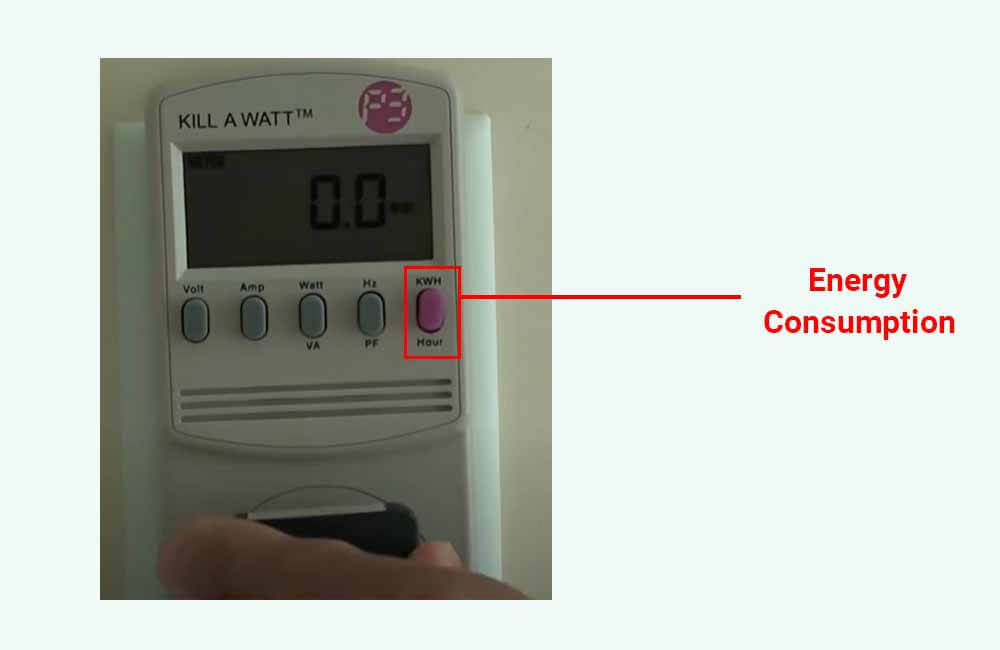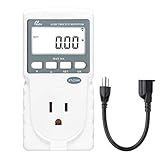I get commissions for purchases made through links in this post.
Although they consume a relatively high amount of energy, it is possible to run air conditioners on a battery bank and solar. The question is, how much battery power do you need to run an air conditioner?
Well, the process of sizing a battery bank for your air conditioner is pretty simple, and can be divided into 3 steps:
- Estimate the energy consumption of your air conditioner or the energy you’d like to offset
- Choose a battery type (battery chemistry)
- Calculate the size of the battery bank that you need
In this article, I’ll provide a few examples that explain this process and I’ll walk you through each of these steps.
However, if you’re in a hurry, here’s a table that estimates the average hourly energy (in Amp-hours per hour) that different air conditioners consume, and the number of 12V-100AH batteries required to offset that energy consumption:
| BTU rating | Avg. Hourly Energy Consumption (Ah/hour @ 12V) | Number of 12V-100AH batteries needed per hour of use | |
| Lithium (LiFePO4/Li-Ion) | Lead Acid (FLA/SLA/AGM) | ||
| 5000 BTUs | 30 Ah/hour | 1 (up to 3 hours of run time) | 1 (up to 2 hours of run time) |
| 8000 BTUs | 45 Ah/hour | 1 (up to 2 hours of run time) | 1 |
| 12000 BTUs (1 ton) | 70 Ah/hour | 1 | 2 |
| 18000 BTUs (1.5 tons) | 110 Ah/hour | 2 | 3 |
| 24000 BTUs (2 tons) | 130 Ah/hour | 2 | 3 |
| 36000 BTUs (3 tons) | 220 Ah/hour | 3 | 5 |
The values provided in the table can be confusing, please continue reading for a more thorough explanation.
How much energy does an air conditioner use?
The amount of energy (in Wh or kWh) that an air conditioner consumes mainly depends on these factors:
- Size or capacity of the air conditioner (in BTUs)
- Age and efficiency of the air conditioner (SEER or EER ratings)
- The outdoor temperature
- The quality of insulation
In other words, the energy that your air conditioner consumes will depend on its size, model, and the particular conditions in which it operates. However, there are a couple of ways to determine this energy usage.
The first and easiest way is to estimate.
How to estimate the energy consumption of your air conditioner?
The energy consumption (in Wh or kWh) of an appliance can be calculated using its power usage or wattage (in W or kW) and usage time (hours):
Energy Consumption (Watt-hours) = Power Usage (Watts) x Usage Time (hours)
However, this would only be precise for appliances that don’t have a duty cycle or a variable-speed drive. In other words, this equation only applies to devices that operate at full capacity 100% of the time.
Light bulbs are the best example of this. When you turn a light bulb on for a certain period of time, you can use its wattage to determine the amount of energy that it consumed.
For example, if you have a 50W light bulb that stayed on for 4 hours, its energy consumption can be calculated as such:
Energy Consumption (Watt-hours) = Power Usage (Watts) x Usage Time (hours)
Energy Consumption (Watt-hours) = 50 Watts x 4 hours
Energy Consumption (Watt-hours) = 200 Watt-hours
So, how are air conditioners different?
Simply put, depending on the type of air conditioner that you have, it either:
- Doesn’t run 100% of the time even when it’s on
- Or doesn’t run at full capacity 100% of the time
So if you use the equation above, you’ll end up with a worst-case scenario estimate.
However, with rules of thumb, you can still use the wattage of your air conditioner, and its usage time to estimate its energy consumption over time.
So which rule of thumb to use? Well, simply multiply by 0.75.
For example, consider a 5000 BTU window air conditioner that uses 400 Watts of power. If this AC unit is left on for 4 hours, its energy usage can be estimated as such:
Energy Consumption (Watt-hours) = Power Usage (Watts) x Usage Time (hours) x 0.75
Energy Consumption (Watt-hours) = 400 Watts x 4 hours x 0.75
Energy Consumption (Watt-hours) = 1200 Watt-hours
If the temperature is somewhat extreme, or if the AC unit hardly stops, you can go with higher multiples (0.9 for example).
If you don’t know the wattage of your air conditioner, please refer to this article: How many watts does an air conditioner use?
Again, when it comes to air conditioners, these calculations will only result in rough estimates. A better and more precise way to determine the energy consumption of your air conditioner is to simply measure it.
How to measure the energy consumption of your air conditioner?
To measure the energy consumption of your air conditioner over a certain period, you’ll need an Electricity Monitoring Device.
With most air conditioners that operate at 110-130 Volts, and that plug into the wall (or inverter), you can use a Kill-A-Watt electricity monitor, or a similar metering device.
You can plug the monitoring device into the outlet, and then plug your air conditioner into it, and leave the AC on for as much time as it usually is.

You can then push the purple button that says KWH and the device will display the amount of energy (in kiloWatt-hours) that your AC unit consumed.
If your air conditioner runs at 220 Volts (as most central air conditioners do), those usually have their separate circuit breaker, which means you probably can’t use the Kill-A-Watt meter. In this case, you can use the Emporia monitor.
However, since these devices use clamp-on sensors and need to be installed on your breaker box, you’ll probably need a qualified electrician to set it up for you.
To learn more about how this works, please watch the videos in this article: Measuring the energy consumption of an air conditioner
In any case, once you estimate or measure the energy consumption of your air conditioner, the next step is to choose the type of batteries you’ll be using.
The next section of this article explains how the chemistry of the batteries you’ll be using influences the size and longevity of your battery bank.
Different battery chemistries and their recommended Depth Of Discharge (DOD)
The Depth Of Discharge (DOD) of a battery refers to the percentage of charge removed from its total capacity. For example, at 70% DOD, a battery could be said to have been discharged to 30% of its capacity. The same battery would be at a 30% State Of Charge (or SOC).
The DOD of a battery has a direct impact on its capacity. The deeper you discharge a battery, the faster it loses its overall capacity.
For example, let’s say that we have a battery that would lose 60% of its capacity after 1500 charge/discharge cycles if it’s only usually 30% discharged (30% DOD/70% SOC). If the same battery is 100% discharged every time (100% DOD), it would lose 60% of its capacity after only 300 cycles.
This means that the capacity of a battery bank – that is supposed to last a few years – doesn’t matter as much as its usable capacity, which itself depends on the recommended depth of discharge. However, this “usable capacity” differs depending on the type of battery.
2 of the most common types of batteries on the market are Lead-Acid batteries and lithium batteries:
Lead-Acid batteries:
This battery chemistry includes:
- Sealed Lead-Acid (SLA) batteries
- Flooded Lead-Acid (FLA) batteries
- Absorbed Glass Mat (AGM) batteries
Generally, the recommended depth of discharge for these batteries is 50% DOD. The number of cycles that a 50% DOD gives you for one of these batteries will depend on the battery itself.
However, as a general rule of thumb, a deep-cycle Lead-acid battery will last around 1000 charge/discharge cycles at a DOD of 50%, which is equivalent to 3 years at a cycle per day.
So if you use lead-acid batteries, and you need your battery bank to supply 100Ah (Amp-hours) of energy at 12 volts, you’ll need 200Ah of capacity at 12 volts.
Lithium Batteries:
There are a couple of lithium-based battery technologies available on the market, but the most common is Lithium Iron Phosphate (LFP or LiFePo4).
Compared to lead-acid batteries, these batteries are generally more expensive. However, a lithium battery will generally last up to 6000 cycles at a 50% DOD. Manufacturers generally recommend an 80% depth of discharge for these batteries, which still allows them to last up to 4000 cycles.
So if you use a lithium battery bank, and you need it to supply 100Ah (@ 12V) per day and last around 10 years, you’ll need a 12V-125Ah lithium battery bank.
Now that we’ve established these basics, the next step is to size our battery bank.
How many 12 volt batteries to run an air conditioner?
In the first step of this process, you’ve learned how to estimate (or measure) the energy consumption of the air conditioner, but that energy consumption is in Watt-hours (or kiloWatt-hours).
To determine the number of 12 volt batteries that you need, simply divide the energy consumption of your air conditioner (in Wh) by 12, and then divide the result by the recommended depth of discharge of the batteries you’ll be using.
You can then divide the final result by the individual capacity of the batteries you’ll be using.
For example, consider a 5000 BTU air conditioner that runs for 8 hours a day, and that consumes 2400 Watt-hours on average. Assuming we’ll be using Lithium batteries to run this AC unit, we can calculate the capacity of the battery bank (at 12 Volts) as such:
Battery Bank Capacity (Ah @ 12V) = (Energy Consumption (Watt-hours) ÷ 12) ÷ DOD (%)
Battery Bank Capacity (Ah @ 12V) = (2400 Wh ÷ 12) ÷ 80%
Battery Bank Capacity (Ah @ 12V) = (2400 Wh ÷ 12) ÷ 0.8
Battery Bank Capacity (Ah @ 12V) = 250 Amp-hours (@ 12 Volts)
To account for system losses, as a rule of thumb, it is appropriate to round this number up to 300 Amp-hours at 12 Volts.
An affordable choice for this battery bank would be 3 of these 12V-100Ah Li-Time batteries. A high-end choice would be 3 of these 12V-100Ah Battle Born batteries.














Very good information provided.
Request information to install solar rooftop plant be provided to me on mail please.
Thanks and regards